Fullerenes
Return to Home Page.................. Page in Progress...............
This page is intended to be a review and discussion of the events leading to the discovery of Fullerenes.The review will be divided into the following three sections due to the fact that I believe presenting the information in this manner leads to a better understanding of the factors and events resulting in their discovery.
I) Development of the Cluster Source
II) AP 2
III) The Experiments
Development of the Cluster Source
I felt the most appropriate place to start this review was the development of the cluster source for the following two reasons:
1) only a handful of people knew of the steps taken to develop it and therefore I thought it might be of interest to the reader,
2) the fact that its development led to the observation, experimentation and explanation of the larger carbon clusters as seen in the supersonic molecular beam experiments performed at Exxon, Bell Labs and then Rice University.
I - Accidental Observation
The initial experiment involved the misalignment of a focused pulsed laser beam direct down the molecular beam axis at the nozzle assembly. This led to vaporization of some part of the nozzle housing (most likely the inner edge of the orifice) and the accidental observation of the production of small Aln clusters ( n < 6 ) .
This proved to be non-reproducible pulse-to-pulse and long-term at that time.
The experiment was performed by T. Dietz, M. Duncan and D. Powers [J. Chem. Phys.(1981) 74,6511]
II - A Suggested Approach
M. Duncan was the first to suggest a possible design that would allow for the production of clusters, via laser vaporization, on a more reliable basis. He outlined this in his thesis. In brief, his suggestion was to construct a nozzle face plate with an orifice as shown here:
The vaporizng laser was to be directed dowm the beam axis and focused in such a manner as to vaporize material from the diagonal portion of the face plate orifice. The idea was not pursued because a literature review revealed that repeated vaporization from a single spot led to the drilling of deep holes from which subsequent vaporization becomes more difficult. With the vaporization laser running at 10 Hz the spot would be hit 600 times per minute, this leads to a pulse to pulse stability that is extremely poor and a rapid decrease in the amount of material injected into the helium carrier gas (i.e.within a few minutes).
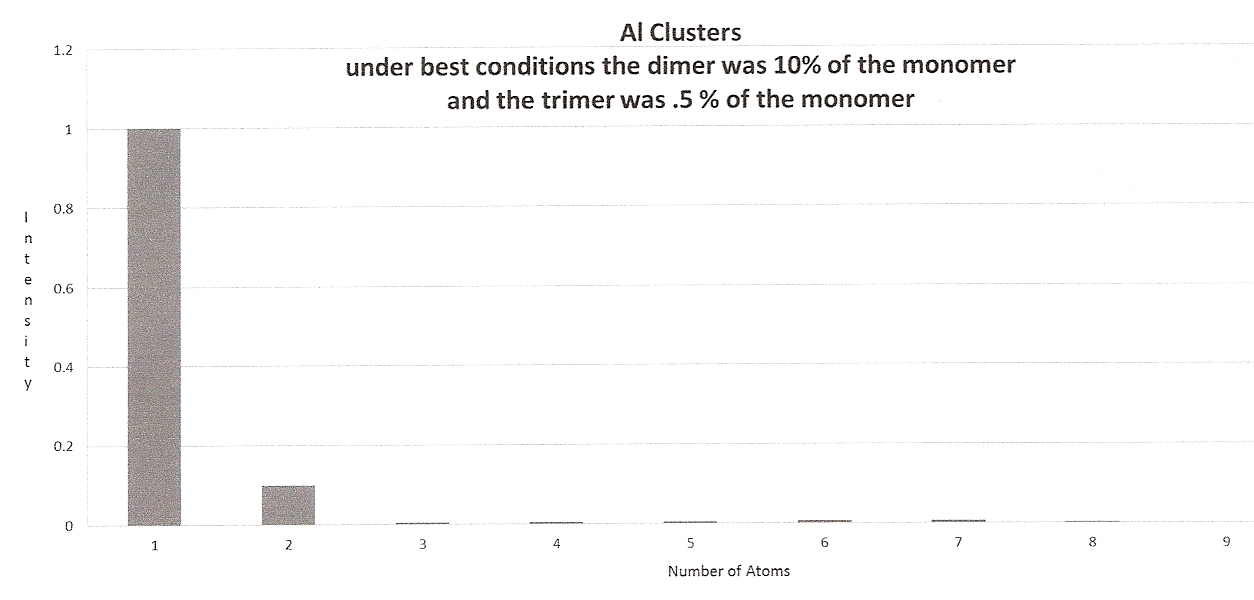
III - Moving Target
Due to the fact that vaporization from a single spot led to an unreliable / unusable source, only designs that would allow the target to be moved to a fresh spot seemed plausible. One of the initial approaches of this type involved using a square target who's x and y position could be controlled (i.e. the target was mounted on a x - y translation stage and the coordinates determined by computer driven stepper motors).
In principle this design met the requirements needed to produce a stable cluster source but in practice would prove difficult to implement.
IV - Rotating Rod
Like researchers previous to us, the rotating/translating rod design was found to be a simple but yet elegant way of dependably producing vaporized plumes of any selected target material.
In the late 60's, Jeunehomme and Schwenker, Wentink et et al. and Leach11,12 et al., used the rotating rod design to examine radiative decay from molecules produced in laser induced blow-off. Some twelve (+) years later, a very similar design was found to be an excellent candidate for construction of a cluster source. The major advantage of this design was the ease with which it could be incorporated into the nozzle housing and vacuum system. Additionally, rods of varying diameter were readily available for most metal, semimetal and semiconductor materials.

The original design called for the distance between the point of laser vaporization and free expansion to be as short as possible. This led to the observation of a large atomic peak and very small diatomic peak. After a lot of effort, a revision of our thinking led to the idea of extensions and the observation of larger clusters, see below.
For more deatils click here
V - Extensions
The cluster distribution which is achieved is governed by a number of parameters. The most important (with the exception of the third body: helium) is the length of the .2 cm channel from the point of vaporization to free expansion. This distance is critical in determining the maximum size cluster which is to be formed. The figure below illustrates a comparison between a .3 cm and 3.0 cm extension. These results are explained simply as permitting additional time for recombination to occur.
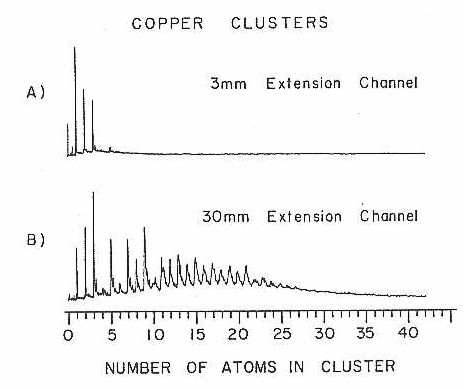
Once the source had been developed to the point of being reliable and stable,the spectroscopic investigation of copper dimer was performed in an effort to characterize and test the source.
It should be noted:
1) That the time between the original observation and having a reliable / characterized cluster source was approximately one year (publication to publication).
2)Although the description above is intended to be brief, the effort was considerable and not every step has been included.
3) At this point the design was transferred to the " Exxon Group" as part of the our ongoing collaboration with Exxon.
VI - Reheat tube
As mentioned in our publications, the cluster beams produced using laser vaporization were found to have translational, rotational, and vibrational temperatures of <5, <10, and 50-100 K, respectively.
The reheat tube's purpose was to raise the temperature of the gas. In the case of SiC2 this was required so that higher lying rotational transitions could be observed allowing us to determine its true structure.
In a supersonic jet it is a simple matter to adjust the rotational temperature by decreasing the backing pressure of the nozzle. Although, when using the laser vaporization technique, it is important that the helium density above the target is as high as possible in order to efficiently produce clusters. Therefore, the decrease in backing pressure normally used would be unsatisfactory. A solution to this problem was found to be the use of a short tube mounted on the end of a pulsed nozzle source. The tube used was 5 cm long with 1 cm internal diameter and mounted co-axial along the beam axis. The carrier gas expanding into this tube reflects off the walls and causes turbulence in the flow. The effect of the turbulence is to reheat the gas before expanding out of the 1 cm diameter orifice. Under these conditions, the final rotational temperature is found to be somewhat higher (15 K) than expansion from the normal nozzle orifice. The rise in temperature depends on the length and diameter of the reheat tube.

.
VII - Reaction tube
The reaction tube was designed and implemented in order to measure relative reaction rates as a function of size. The reaction tube design is shown from both a side and end-on view in the figure.
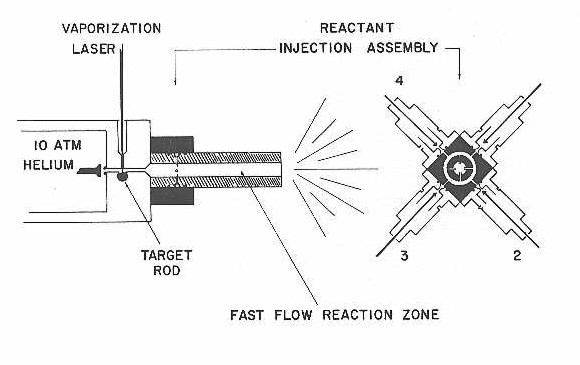
Four hypodermic needles, positioned approximately 2 cm downstream of the .2 cm diameter channel and protruding .3 cm into the reaction tube are used to inject dilute reactants into the flowing helium plus metal clusters. These needles are equally disposed around the diameter the reaction tube and are supplied by a common annular reservoir of .5 cm3 in volume. This reservoir is fed by four independently controlled pulsed reactant nozzles (General Value, Model # 9-199-902) each being supplied by independent gas-lines. These nozzles were adjusted to deliver 3 ms wide (FWHM), with a backing pressure of a few atmospheres. Their firing was synchronized 1 ms before the main cluster nozzle, so as to provide a steady flow of the reactant gas during the 400 us of the main nozzle pulse. The annular reservior served as a gas ballast feeding each of the four injection needles equally, thus ensuring that the flow of reactant into the reaction tube is independent of which nozzle is fired. The overall design of this injection scheme is necessary in order to eliminate a number of possible errors. In measuring relative rates of reaction, one must make sure the results are independent of which reactant nozzle is used, eliminating systematic errors that would otherwise be present. The extension of the needles .3 cm into the reaction tube, along with their ends being filed at 45 degrees and positioned such that the flow will be towards the oncoming helium plus clusters, has been designed to ensure turbulent flow causing a complete mixing of reactants.
VIII - Replacing the Rotating Rod with a Rotating Dics
Replacement of the rod with a disc allows one to use a wafer.
In principle and practice there is little effect on the production of clusters (i.e. using a focused laser to vaporize material from a rod or a wafer would lead to the same result.)In addition, regarding the issue of reliability and stability there is little difference in comparison to the rotating rod design.

Note: This step of the cluster source development was carrier out by S. O`Brien and J Heath. Also, it should be noted that this step and the next were carried out at the same time, but I have separated it into two steps (i.e. source and extension) in an effort to show the effect of each.
IX - Annealing / Integration Cup
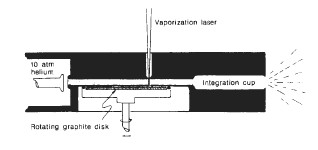
As previously stated, the critical parameter for cluster formation (with the exception of the third body: helium) is the diameter, length and shape of the exit orifice (extension) for atom by atom or piece by piece growth.The exit orifice would likely be the determining factor in cluster formation for this source, although in the case of carbon, small clusters and large clusters (fullerenes) likely have different growth mechanisms.
The bottom line, in my opinion, is that without the development of a cluster source based on laser vaporization fullerenes would most likely not have been discovered during the 1980's. The first method for producing fullerenes used laser vaporization of carbon in an inert atmosphere "the cluster source", although this produced only microscopic amounts of fullerenes.
.
AP 2
A side view of AP 2 is show in the figure below. It is a typical pulsed molecular beam machine consisting of three chambers. Prior to the development of the cluster source based on laser vaporization AP 2 was used for a variety of experiments such as Vibrational-Relaxation.The molecules to be studied were simply seeded into the helium carrier gas pior to expansion by either mixing the gas into the helium or bubbling the helium through the liquid.
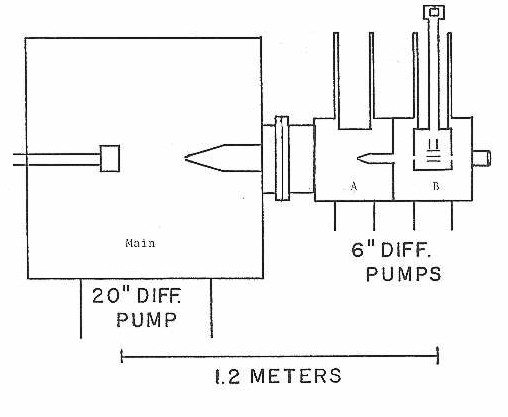
When AP 2 was initially constructed, its design included two features that proved beneficial to the development of the cluster source. A large main chamber and Time of Flight Mass Spectrometer (TOFMS).
Main Chamber
The main chamber was a large stainless steel cylindrical can with a volume of approximately 600 liters and was pumped by a HS20 Varian diffusion pump (20 inch diameter, type 165) capable of pumping 21,000 liter/s of helium in the range of l.3 x lO-3 to l x lO-9 torr. Under normal operating conditions, a base pressure of l x lO-4 and l x lO-6 torr was maintained with the molecular beam on and off, respectively.
The size and pumping capability made AP2 ideal for the development of the cluster source. It allowed for intense pulses of helium to be produced by the Grant type nozzle leading to approximately 1 atmosphere of helium over the target during vaporization.
TOFMS
The Time of Flight Mass Spectrometer (TOFMS) allowed for the detection and study of neutral (zero charge) clusters produced by the source. Only neutral clusters could be studied because a constant voltage was applied to the acceleration plates of the TOFMS (i.e. any incoming charge species would be deflected by the electric field).
Once the neutral clusters entered the ionization region of the TOFMS, they were ionized using one of two schemes.
1) The first scheme involves a direct one-photon ionization of all species within the molecular beam. This process is mainly used for investigation of cluster distributions and relative intensities although, in order for intensity information to be useful one must assume similar absorption cross sections for all the species present. Normally with this scheme the F2 excimer laser (7.98 eV) line is used. The only major factor which must be considered with this type of ionization is the laser intensity. The photon flux must be kept low enough so that no multiphoton processess will occur.
Excimer....Wavelength....Energy
F2.......157 nm....7.897 eV
ArF.... 193 nm....6.424 eV
KrF.... 248 nm....4.993 eV
XeCl....308 nm....4.025 eV
XeF.... 351 nm....3.532 eV
KrCl....222 nm....5.584 eV
In addition, comparison of relative intensities can only be made assuming similar detector response and no fragmentation upon ionization.
If fragmentation on a large scale has taken place, then interpretation of the data becomes extremely complex, if not impossible.
2) The second scheme, a resonant two-photon ionization, is used mainly for the probing of bound excited electronic states of the species under study. This type of ionization can be accomplished through either a two-photon, one or two color scheme. In the two color process, two photons of different energies are involved. The first photon (excitation) is generated from a scanning Nd:YAG pumped dye laser. The second photon (ionization), chosen to be incapable of ionization, is supplied from a fixed frequency laser (either an excimer or Nd:YAG). The overall process is a resonant absorption of the excitation photon to a bound level of an excited state from where the ionization photon promotes the electron into the ionization continuium. In the two-photon, one color scheme, both photons are of the same energy and are supplied by the same laser. In this later case, it is understood that only bound states of equal to or greater than one-half the ionization energy, will result in ion production.
For more deatils click here
The Experiments
This section will discuss the supersonic molecular beam experiments conducted on carbon clusters at Exxon, Bell Labs and then Rice University, and will be followed by a discussion of the experiments involving the production of bulk quantities of fullerenes and related materials.